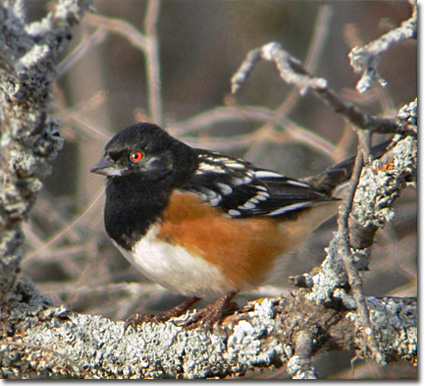by John Shackford

Although the Spotted Towhee (Pipilo maculatus) and Eastern Towhee (P. erythrophthalmus) are closely related, they are currently classified as separate species. The debate about “splitting” these into two species or “lumping” them into one has an interesting history. The American Ornithologists’ Union (AOU), official arbiter of bird nomenclature, periodically puts out updated Checklist Editions that show name changes since the previous AOU Checklist Edition. From the AOUs 1st Edition (1886) through the 4th Ed. (1931) the Spotted Towhee was split as a separate species called the Arctic Towhee, while the Eastern Towhee was known simply as Towhee. By the 5th Ed. (1957) through the 6th Ed. (1983) the two towhees were lumped as a single species, the Rufous-sided Towhee. By the 7th Ed. (1998), the most recent, the towhees had been split once again into two species, the Spotted and Eastern Towhees.
In his “Oklahoma Birds” (Sutton 1967), Dr. Sutton made the following statement (in which I have substituted common names for Latin names): “…in my opinion there is no more justification for throwing the two [towhees] together than for throwing togetherYellow-shafted and Red-shafted Flickers, Myrtle and Audubon’s Warblers, Baltimore and Bullock’s Orioles, Indigo and Lazuli Buntings, and possibly even Rose-breasted and Black-headed Grosbeaks because…each of the twelve forms ‘breeds true’ throughout a vast area.” Currently, only the Flickers (lumped as Northern Flicker) and Warblers (lumped as Yellow-rumped Warbler) are considered only one species. I believe I am accurately paraphrasing something Dr. Sutton once said about nomenclature and closely related populations: Just wait a while and things will change.
Males of both the Spotted and the Eastern Towhee have black backs, with at least some white spots on the back, considerably more of these white spots on the back of the Spotted Towhee. The females of the two species differ because the back color of the female Spotted can be either black or gray, while that of the female Eastern is a chocolate brown; females of both species also have white spotting on the back similar to the respective males. Both species have rufous on the sides of the breast and white in the middle of the breast.
In central Oklahoma, the Spotted Towhee is our common towhee. A very few Spotted Towhees nest in the Black Mesa area of the Oklahoma Panhandle; their song is a “harsh buzzy trill” (Kaufman Field Guide 2000). A few Eastern Towhees nest in northeastern Oklahoma; their song is “drink your teeeeee.” But both species are primarily migrants and winter residents in Oklahoma. On our Oklahoma City Christmas Bird Count there are usually about 50 Spotted Towhees reported for each Eastern Towhee. In central Oklahoma the Spotteds may actually be a little less common than 50 to1, because the Spotted is the “default” towhee when a bird is not checked carefully.
Not long ago my wife Melissa noticed an Eastern Towhee eating birdseed in our yard. During the snowstorm a few days later, we had both a Spotted and the Eastern Towhee feeding in the yard, quite a treat.
An Addendum to last month’s Bird of the Month, Ring-billed Gull. Although this gull spends time at trash dumps, including mall parking lots, I do not consider it a “trash” bird in the way I do the Starling and House Sparrow. One difference is that of the three species, only the Ring-bill is a native species; they have expanded opportunistically within their historic range, but not as an invader of new territory. Furthermore, they do not have a strong negative impact on other species as do the Starling and House Sparrow.
